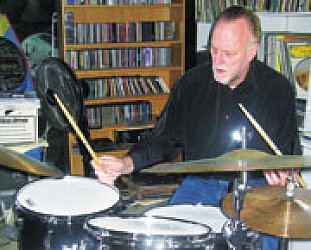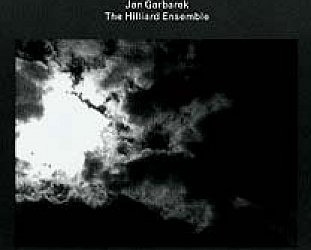Graham Reid | | 6 min read
Alan Brown: Abandoned Fences

Auckland-based keyboard player and composer Alan Brown has been around the New Zealand jazz scene for decades in groups like Blue Train and the Grand Central Band, has toured and played with the likes of Nathan Haines and Caitlin Smith and of course helmed his own trio . . . as well as passing on the message through his teaching.
But his new album Silent Observer takes a quieter turn and is influenced by the spacious ambient music of Brian Eno, David Sylvian and music on Eno's Obscure label. Here at Elsewhere we've described it as "for those times when you need to find the space between those innumerable noisy notes that deafen our days".
It really is a beautiful album, recorded live in the Auckland Town Hall's Concert Chamber and of course is improvised, because Brown -- with a lifetime of piano music in his soul -- can draw on a deep well of ideas.
Cannot commend this one highly enough, so here we take the opportunity to invite Alan Brown to answer our Famous Elsewhere Jazz Questionnaire.
The first piece of music, jazz or otherwise, which really affected you was . . ?
The very first thing? Probably Prokofiev’s Peter and the Wolf from my earliest recollections. However there have been many profound moments since then – I guess two early paradigm-shifting moments were King Crimson’s Red – especially the track Starless -- and Brian Eno’s Music For Films. Seemingly opposite genres but essentially the same boundary-stretching, emotive approaches that I love.
When did you first realise this jazz thing was for you?
I had been listening to a lot of crossover music such as Steely Dan and the Pat Metheny Group for quite a while, so was familiar with the jazz sensibility and harmonic concepts, but it wasn’t until someone lent me a copy of Bill Evans’ Explorations that I realised this is my thing. I think I had that on perpetual rotate in my car for several months…
What one piece of music would you play to a 15-year old into rock music to show them, 'This is jazz, and this is how it works'?
Having been introduced to jazz through the same process of jazz-rock by the likes of Steely Dan, Pat Metheny and Weather Report, I’d probably pick something that was contemporary which reflected the sound and style of what today’s rock listeners go for.
Don’t underestimate today’s ‘rock’ youth – they are very comfortable with odd time signatures and unusual song forms.
With that in mind I’d probably pick something like Aaron Parks’ Nemesis from his album Invisible Cinema for it’s Radiohead-esque melody and dark edge, or the track Entertain Me from Armenian pianist Tigran Hamasyan’s latest release Mockroot – especially if they’re into hard rock or metal. A fantastic track! I love how these guys are pushing the boundaries of what is considered ‘jazz’ and creating something refreshing and unique.
Time travel allows you go back to experience great jazz. You would go to . . ?
Due to my initial love of Bill Evans’s music and especially the trio with Scott LaFaro and Paul Motian, I’d go to the Village Vanguard sessions which were only days before LaFaro died. The communication and understanding that existed between these guys was the pinnacle, for me, of piano trios and of what a jazz group aspires to in terms of ‘the moment’.
Which period of Miles Davis' career do you most relate to, and why: the acoustic Fifties; his orchestrated albums with Gil Evans; the acoustic bands or fusion of the late Sixties; street funk of the Seventies or the Tutu album and beyond in the Eighties . . .
I like a lot of what Miles did, precisely because he broke boundaries and thumbed his nose at the jazz purists and critics. However, a special period for me was the 60’s quintet with Hancock, Carter, Shorter and Williams – they were very much in tune with each other but also not afraid to take risks. Much of what they did was totally ‘free’ yet they understood song form and had a playful aspect to their collective improvisation.
Any interesting, valuable or just plain strange musical memorabilia at home?
Apart from a LOT of old keyboards?! Rhodes, Wurlitzer, Clavinet, Hammond… Actually I have a doumbek which I bought last year from an Arab ‘shuk’ or market, in a small town called Acre on the coast of Israel. I love the sound of the doumbek/darbukka drum and this one is a beautiful Egyptian style ceramic drum with mother-of-pearl inlay. I’m slowly learning all the various rhythms and playing techniques. Total fun.
The best book on the jazz life you have read is . . .
I’ve read quite few jazz biographies and autobiographies which mostly leave me cold. Either they’re trying too hard to be clever and/or shocking, or else read like a market analyst’s report – totally detached and dull. However one book I did enjoy, which the late Dave McArtney lent me, was Charles Mingus’s Beneath The Underdog. You sort of have to understand Mingus’s approach to music to take some of this with the same tongue-in-cheek attitude, but it’s very down-to-earth, very authentic.
In fact, one of the tunes off my 2011 album Between The Spaces, is called Dancer and Chess – named after two characters from the book that Mingus met when he spent time in a mental hospital in New York. Highly recommended read.
If you could get on stage with anyone it would be . . . (And you would play?)
Led Zeppelin and I’d LOVE to play No Quarter, bass pedals and all!! Actually true – but if I must have a jazz slant it would be with Thelonious Monk, and no, I wouldn’t play, I’d just absorb the moment.
I love Monk’s unorthodox, angular approach and his incredible writing. In fact, many years ago in my early jazz period, I had a vivid dream where I was in the studio with Bill Evans, Monk and an unknown rhythm section. There were two pianos, Evans was on one and I was on the other. Monk was leaning over my shoulder showing me some piano voicings…
 The three films you'd
insist anybody watch because they might understand you better are . .
.
The three films you'd
insist anybody watch because they might understand you better are . .
.
Now that’s a difficult one. Probably 2001 A Space Odyssey, The Neverending Story and Tarsem Singh’s The Fall.
These are three films that have stayed with me for whatever reason… Maybe it’s the combination of escapism, stillness and aloneness, philosophy and imagery, who knows?!
The last CD or vinyl album you bought was . . . (And your most recent downloads include . . .)
I must admit, as much as I hate mp3s, I haven’t bought an actual CD for a while. Probably the last one was Sigur Ros’s Kveikur. In terms of downloads, I like sites like Bandcamp as you can download in FLAC which gives me a lossless listening ability.
On overseas websites I have recently been discovering Norwegian artists like Jan Bang, Arve Henriksen and Eivind Aarset. Fantastic music – very ambient, dark, spacious and experimental.
One jazz standard you wished you had written . . .
That would have to be Nardis, and not just because of the Bill Evans connection. I love playing that tune and there is something about it that I really enjoy exploring in terms of improvisation. Of course, apart from what Real Books and Google say, Miles most probably didn’t write it and neither did Bill Evans.
It was most likely written by guitarist Chuck Wayne, who had a Slavic ancestry, which would explain it being in the trumpet-unfriendly key of E minor, as well as its oriental overtones.
The poster, album cover or piece of art could you live with on your bedroom forever would be . . .
I had a huge Led Zeppelin poster on my bedroom wall back in the day. I wonder what happened to it…? I also had an Abba poster before that but lets not go there…
Three non-jazz albums for a desert island would be . . ?
Only three?! Mozart Piano Concerto No. 20 in D Minor, Massive Attack’s Mezzanine and Steve Reich’s Music For 18 Musicians. Now there’s an eclectic mix.
They all have had, and continue to have, a profound impact on me but for different reasons. I have always loved Mozart and his melodies, especially this one; Massive Attack’s album just absorbs me – I love the darkness, textures and overall mood.
As for Steve Reich, I never get tired of this – something about his approach to minimalism I find captivating.
 Your dream band of
musicians (living or dead) would be . . ?
Your dream band of
musicians (living or dead) would be . . ?
Wayne Kranz on guitar, John Bonham on drums, Brian Eno on atmospheres, Bjork on vocals and Ornette Coleman to really take things somewhere else. Probably would be mayhem but it would be pretty creative!
And finally, is there a track on your most recent album you would love people to hear. And, if so, why that one?
I think Abandoned Fences from Silent Observer gives a taste of the slightly melancholic stillness and reflection that is a large part of my musical expression right now.







post a comment